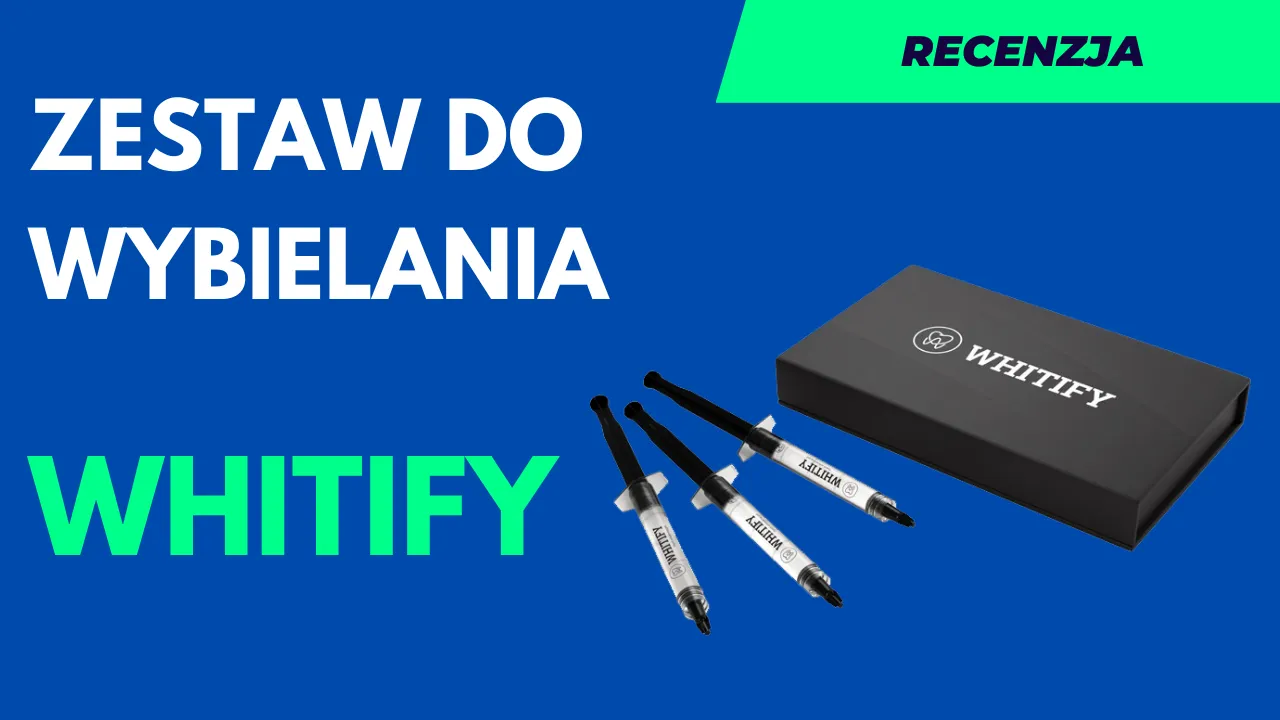There are many preparations that are intended to whiten our teeth - various types of toothpastes, gels or trays that are supposed to replace the teeth whitening procedure at the dentist.
When planning such a trip, you should have in your pocket some 1,500 - 1,600 zlotys, if you want to use a special whitening lamp. So it is reasonable to consider that this is an expensive investment that not everyone will be able to afford.
With help comes the manufacturer Whitify System, which has developed its own product - a home teeth whitening kit for which we will pay a modest 215 zloty.
When approaching a new invention, however, we should not focus on the price, but what we get for that price.
What does the Whitify teeth whitening kit contain?
The kit consists of gel, UV lamp, tooth cap, shade template and instructions for use. The manufacturer states:
Whitify whitening gel is:
Baking soda Has abrasive properties. Effectively removes stains.
Aloe leaf juice and pomegranate fruit extract have antibacterial properties - effectively protecting teeth from decay.
Menthol Refreshes breath and gives a pleasant cooling sensation.
Manufacturer's website / Official product page

Composition and effects of Whitify System
All of these statements are true. They are, baking soda has long been used to whiten teeth by abrading a thin layer of enamel - as an abrasive element, however, it is very gentle and used correctly will not damage teeth.
Aloe vera, pomegranate fruit - As much as possible have antibacterial properties. Menthol...Menthol probably doesn't need to be introduced to anyone.
Even so, it is not baking soda that is the bleaching ingredient in this mix for a simple reason - under UV light it breaks down into carbon dioxide, sodium carbonate and water.
Look for the whitening agent in the full formulation provided by the manufacturer - it is sodium chlorite, which under a UV lamp will decompose into chlorine dioxide, oxygen and sodium chloride.
Chlorine dioxide, on the other hand, is a strong bleaching agent that can whiten teeth as much as possible. In the amount in which it is in Whitify gel - and it is penultimate in the composition - it should not do any harm.
For this reason, the gel overlay should be kept for a quarter of an hour - there is no point in keeping it longer if everything that was supposed to overreact - has overreacted.
Chlorine dioxide in research in vivo (Ablal et al., 2013) has performed very promisingly as a teeth whitening agent. Nevertheless, it should be noted that the scientific community is also paying attention to the safety of this agent and the need for more research on it (Kwon et al., 2015; Ribeiro et al., 2019).
Opinions about Whitify System
So in conclusion - is the Whitify System worth the two hundred and fifteen zloty? If we skip the marketing of this kit and focus on how and why it works - then yes.
The process by which the Whitify System whitens teeth is relatively simple to work out. However, lest it be too pretty, it is absolutely necessary to familiarize yourself with the information on the use of its product provided by the manufacturer and its instructions.
Special attention should be paid to the following. The gel absolutely should not be on the gums.
According to the manufacturer, the treatment lasts six days, during which we use a gel pad and lamp for fifteen minutes. I strongly advise against extending the use of the system beyond the stated six days. According to the manufacturer, customers usually repeat the process after 3-6 months, but this is very individual.
This is a product from the category of those whose action looks logical. However, it is important to remember that the effects will not be the same for everyone - one will be delighted, and another will barely notice any change.
This runs from individual differences between people - not because the whitening factor works "selectively," but because everyone starts from a different place.

Literature
Li Y. Stain removal and whitening by baking soda dentifrice: A review of literature. J Am Dent Assoc. 2017 Nov;148(11S):S20-S26. doi: 10.1016/j.adaj.2017.09.006. PMID: 29056186.
Surjushe A, Vasani R, Saple DG. Aloe vera: a short review. Indian J Dermatol. 2008;53(4):163-6. doi: 10.4103/0019-5154.44785. PMID: 19882025; PMCID: PMC2763764.
Dahham, Saad Sabbar, et al. "Studies on antibacterial and antifungal activity of pomegranate (Punica granatum L.)." Am. Eurasian J. Agric. Environ. Sci 9.3 (2010): 273-281.
Ablal, M. A., Adeyemi, A. A., & Jarad, F. D. (2013). The whitening effect of chlorine dioxide-An in vitro study. Journal of Dentistry, 41, e76–e81.
Kwon, S. R., & Wertz, P. W. (2015). Review of the Mechanism of Tooth Whitening. Journal of Esthetic and Restorative Dentistry, 27(5), 240–257.
Ribeiro, J. S., Oliveira da Rosa, W. L., Silva, A. F., Piva, E., & Lund, R. G. (2019). Efficacy of natural, Peroxide-free tooth-bleaching agents: A systematic review, meta-analysis, and technological prospecting. Phytotherapy Research.
